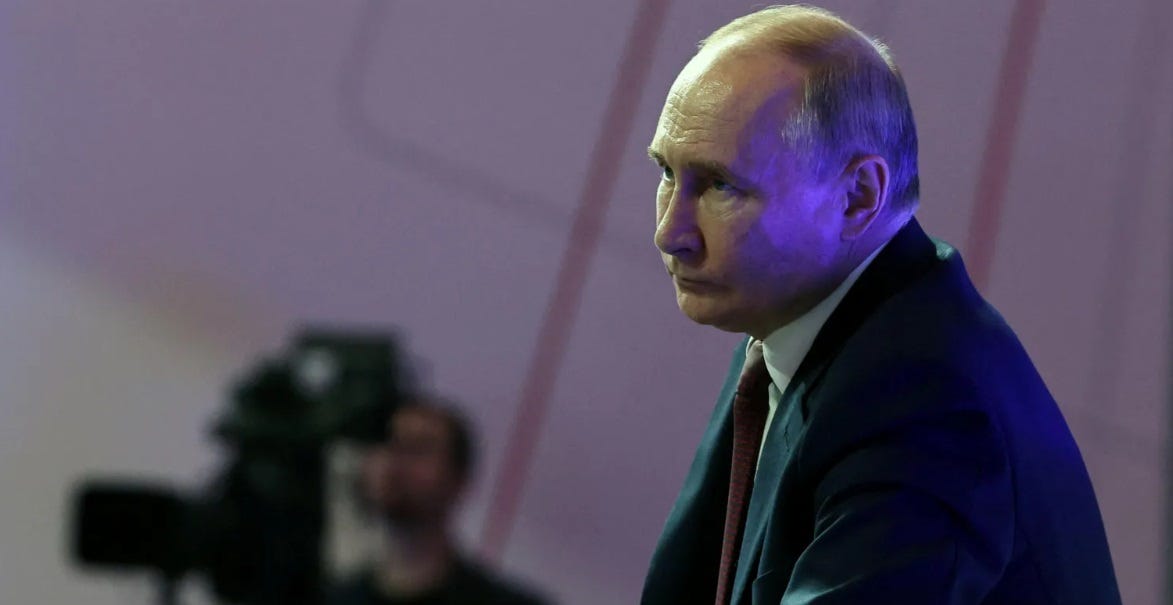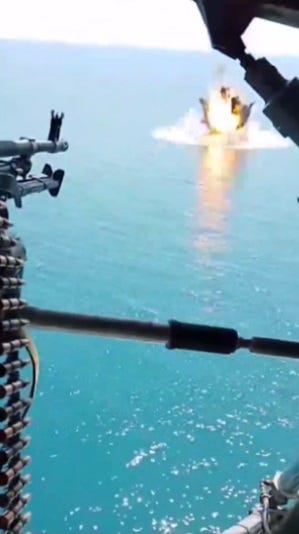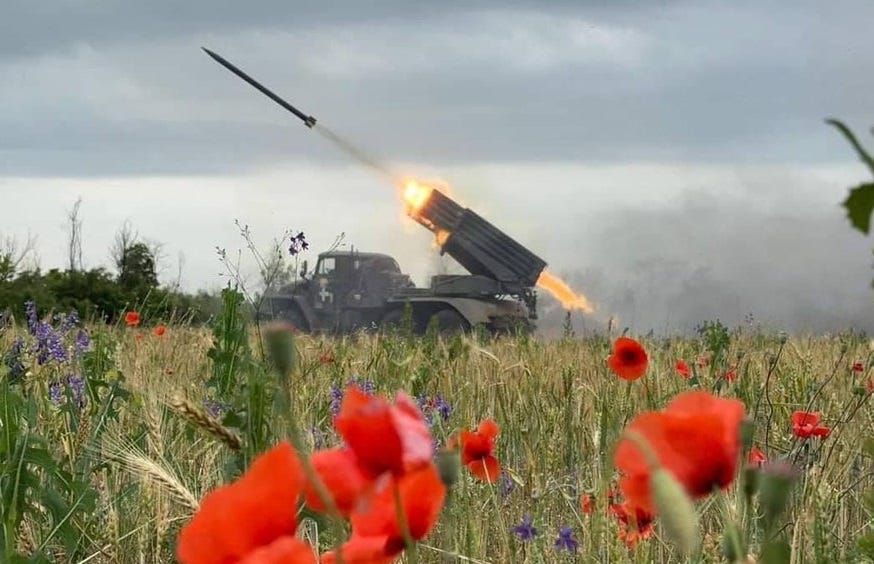Indulging in the Future: This Week in Ukraine
Zelensky holds a party, the G7 gives a loan, strategic attacks, Azov absolved, and more.
1. Tell Me, Again, How This Thing Ends?
It was a busy week for the future of Ukraine. Zelensky held a peace summit in Switzerland that was not attended by anyone who could have actual influence on the peace process. On cue, Putin presented the details of an insultingly ridiculous cease-fire agreement. The leaders of the rich Western countries gathered in Italy and bravely decided to give Ukraine a minuscule percentage of frozen Russian assets in the form of a loan. And finally, this weekend, Ukraine is holding a recovery conference in Berlin to explain to the world the astronomical figure of how much it’s going to take to rebuild Ukraine into a viable, self-sufficient economy. Underlying all this is the need to establish lasting peace in Ukraine.
It turns out Bürgenstock, Switzerland, is not the home of ugly hippie sandals popular with internet influencers and 18th-century cobblers. It is where Zelensky attempted to flex his political clout this week, with limited success. China, Russia, Joe Biden, India, Brazil, and most of the Global South did not attend his peace summit. But, those who did attend were apparently treated to over an hour of each delegate being personally received by Zelensky (video here). Way to stay on target and get down to business.
In terms of pounding out realistic terms for lasting peace, it was a non-starter. Zelensky rehashed his 10-point peace plan, which included the return of all Ukrainian territory. As one might expect, this week, Putin offered an absurd overture to peace in the form of an immediate ceasefire if Ukraine completely withdrew from the four currently partially occupied oblasts and pledged never to attempt to join NATO. Neither of these peace plans is realistic. Neither of these countries is ready to negotiate. Neither of these countries could negotiate from a position of strength. Zelensky should have been holding a War Summit because this war will most likely drag on, and he should have discussed what the next three years of support would look like.
This week, Biden and Zelensky made some progress toward that future by signing a bilateral security agreement. The ten-year agreement includes material support, intelligence sharing, and training—about what the US provides now. Similar to the 14 other pacts signed with various nations, this agreement will do little to change the actual security situation for Ukraine. It is not a treaty and is subject to review when the current administration leaves, a very possible scenario beginning in January.
Speaking of once and (possible) future administrations, Trump seems adamant about immediately securing a peace deal if he is elected. It was only with Trump’s support the recent $61 billion Ukraine aid package passed the US House. Part of Trump’s acquiescence was that he was convinced that supporting Ukraine now would enable his peace process in January. A few months ago, the common perception was that Russia decidedly had the upper hand, and Ukraine needed a boost to even the playing field and bring both sides to the negotiation table. But Trump has a problem with his plan. He can’t tell Russia that he will increase aid to Ukraine massively and, at the same time, tell Ukraine that he will restrict aid to Ukraine. Even if these conversations were behind closed doors, I doubt if Putin would believe him. If a Trump peace plan in January would have any hope of success (although I do not think it’s possible), what Trump will have to do is threaten Putin with drastically increased aid to Ukraine (including NATO admission) while simultaneously threatening Zelensky with political damage. Given Trump’s history with Zelensky, it doesn’t seem off-brand for Trump to attempt to force Zelensky’s removal. Trump could further influence Ukraine by restricting (or boosting/pledging) recovery funds after the war and promising to station US troops in Ukraine after the peace deal is signed. This negotiation could play out in many ways, but both sides need to be motivated.

Before negotiations begin, Ukraine must break Russia’s will. I have written recently about how Ukraine could achieve this aim (escalation to bring the West further into the war and the corresponding depletion of strategic resources—see “Nice Things,” below) and how they probably could not achieve this end (see The Dead Russian Fallacy). Likewise, Ukraine’s will is tied to its war endurance, which will continue to wane. The eventual, wide distribution of the “fair burden of war for all” will increase the political desire for Ukraine to sue for peace.
We have to separate the rhetoric from the reality. The West wants the war to end. The longer this thing draws out, the better positioned Putin will be during negotiations. War fatigue will continue to inflict Westerners and Ukrainians. Putin is prepared and has attempted to prepare the Russian people for a long war. The key to ending this war is to hurt Russia as much and as quickly as possible. Regardless of when negotiations occur, the key to Ukraine’s leverage is overwhelming support, unity, and resolve from the West.

2. OG’s at the G7
This week, Biden and the representatives of well-off countries gathered in southern Italy to plan the world’s economy and complain about how Davos was way more fun. The most salient issue from the conference is that Ukraine will receive a $50 billion loan to be secured by the interest from the over-$300 billion in frozen Russian assets trapped in Western banks. Given that the World Bank and others estimate the current Ukraine reconstruction costs at around $500 billion, it seems reasonable that confiscating all these assets would be a simple path to retribution. But, doing so would present an interesting conundrum for Western elites. Illegally invading another country is disruptive to the global order, and Russia must be punished. Abruptly seizing assets is also disruptive to the global order. Clearly, making Putin and the oligarchs pay for the death and destruction they’ve caused to Ukraine is the most justifiable and morally right path forward. So why is the West hesitant to declare that all these funds will go to Ukraine? Put another way: Why are global elites hesitant to take other elites’ money? I think the second question is a more revealing perspective on the liberal world order.

3. This is Why We Can’t Have Nice Things
Ukraine continued its campaign of destroying expensive Russian hardware this week by attacking valuable air, land, and sea assets. On Sunday, Ukraine destroyed or seriously damaged two of Russia’s few 5th-generation fighter jets, the unjustifiably exalted Su-57 Felon. Russia only has an estimated 20 or so Felons, and like their elusive Armata T-14 main battle tank, the Kremlin is loath to deploy it to the Ukrainian battlefield, probably because Russia doesn’t want the world to know how inept its military-industrial complex has become. My problem with this strike is the same problem I have with all of Ukraine’s successful attacks on high-value targets: the scale of the attack was too small. Ukraine (specifically the HUR—their military intelligence unit known for its audacious and successful strategic attacks) has a history of conducting attacks against single targets, giving up its methods and the element of surprise. Now that Russia knows what Ukraine knows, it’s going to take preventive measures to ensure Ukraine can’t attack any other Felons. Ideally, Ukraine would use UAVs to conduct a massive, simultaneous, crippling blow to hundreds of strategic assets, but they can’t—another reason Ukraine needs more support.
Some notable other Ukrainian strikes this week (or revealed this week) include the drone attack on the Novoshakhtinsk refinery in Rostov, causing $540 million in damage, and the assault on Russian ships in the Sea of Azov. The interesting thing about this naval attack is how the Ukrainians were able to get their unmanned surface vessel (USV) drones into the Sea of Azov. The coastline is controlled by Russia, and the only water inlet is through the Kerch Strait (ostensibly also controlled by Russia). The Russians recently moved the remainder of their Black Sea Fleet into the Sea of Azov to protect it from Ukrainian naval threats. Now, it looks like there’s nowhere to hide.
4. Azov Absolved
It looks like the Pentagon is finally going down its list of all the possible ways the US government can help Ukraine’s military. This week, the US lifted the ban on support to the Azov Brigade. I wrote about the prohibition on Azov support in April when Congress passed the $61 billion aid package. At the time, the US considered Azov an extremist organization with a neo-Nazi history accused of multiple human rights violations. Now, we can let the healing begin.
It's unclear exactly what materiel support they will be getting. The Azov Brigade is primarily a light infantry unit fighting in the forests of the Donetsk oblast. Given US Javelins, they could begin to be used as mobile missile troops to engage Russian armored columns across the front. Hopefully, they’ll be used to spearhead the amphibious assault of Crimea.
5. [Video] The State of Nature
For everyone who was appalled and perplexed on February 24th, 2022, at the idea that, in the 21st century, two countries could go to war over one country’s greed and blind aggression, this week’s video (here) is a little reminder that sometimes we have to forget what we think we know, because the universe has no rules.



